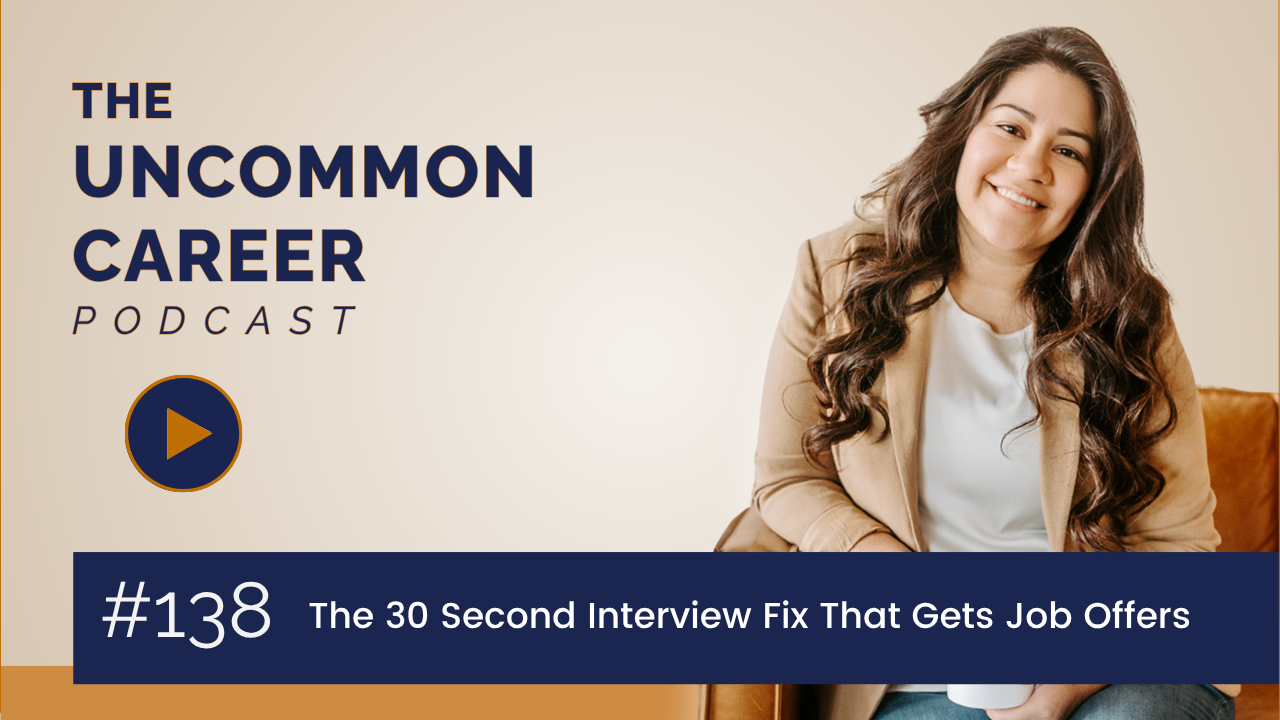138. The 30 Second Interview Fix That Gets Job Offers
Nov 18, 2025
The 30-Second Interview Fix: Make Your Best Value Unmissable
Thirty seconds can flip an interview from random Q&A to a focused conversation about what makes you the right hire. The fix isn’t a trick; it’s a fast, repeatable way to surface strengths that are so familiar they’re easy to forget under pressure. When those strengths are named up front—in the interviewer’s language—answers stay relevant, nerves settle, and the rest of the conversation orbits around proven value.
|
Listen on your favorite podcast app: |
| |
Step 1: Inventory Strengths Once—So You Can “Select in 30” Forever
The heavy lift happens before interview day. Build a one-page inventory of strengths under seven headings. Use brief bullets, not essays, and focus on proof.
-
Industries: list every industry touched, even if the function was “industry agnostic.” Unionized environments, regulated sectors, hyper-growth spaces—each signals distinct readiness.
-
People: veterans, enterprise buyers, SMB founders, executive stakeholders, frontline teams—naming audiences shows stakeholder fluency.
-
Places/Contexts: global, multi-site, remote-first, on-prem—context changes how work gets done; call it out.
-
Methods/Systems/Tech: frameworks used, platforms mastered, systems stabilized—translate tool names into outcomes (speed, quality, risk).
-
Training: certifications and formal upskilling, including “older-to-current” exposure that gives historical perspective (e.g., early AI iterations).
-
Niche Skills: uncommon combos that change how problems are solved (e.g., HR + law, finance + design).
-
Situations: crises cleaned up, audits survived, mergers stabilized, zero-to-one builds, scale-ups—moments that reveal judgment under pressure.
This master list is the engine.
With it in hand, the 30-second move becomes easy.
Step 2: Pick the Top Three—Fast
Open the role description and ask, “Which three strengths on the inventory matter most for this team in the next 90 days?” Circle them. These are the anchors for your opening answer and the lens through which all other answers pass.
If two items seem equal, choose the one that’s rarer in the market or closer to the team’s immediate pain (speed, quality, cost, risk, retention).
Step 3: Lead with a 3-Beat “Tell Me About Yourself”
This is the only response worth rehearsing until it feels effortless. Keep it to ~45–60 seconds on the first pass; the “fix” is that you can trim to 30 when needed without losing the signal.
The 3 beats:
-
Now/Focus: one sentence that positions current scope in the employer’s language.
-
Best-match strengths (the Top Three): one sentence that names the three, tied to outcomes.
-
Why it matters here: one sentence that links those strengths to the role’s first problems to solve.
Rehearse for flow—not theatrics—until the structure is automatic and the wording sounds like how you actually speak.
The point isn’t a script; it’s a spine that holds under stress.
Step 4: Use Micro-Bridges to Keep Answers Aligned
After the opener, connect every question back to the same three anchors. Three tiny phrases will keep the conversation orbiting your value instead of drifting into a résumé tour.
-
Context hook: “In a [relevant industry/situation] context, the approach that worked was…”
-
Method hook: “Using [method/system], the team cut [problem] by [measure]…”
-
Stakeholder hook: “With [stakeholder group], what moved the needle was…”
These aren’t detours; they are signposts that help the interviewer track exactly why experience matters here.
Step 5: Build a 30-Second Pre-Call Cue Card
Right before the interview, glance at a single index card (or top of notes doc). No more than six lines:
-
Role title + two success metrics pulled from the posting.
-
Your Top Three strengths for this role.
-
One recent, numbers-backed example that proves each strength (scope + change).
This keeps working memory clear, reduces blank-outs, and makes it easy to tailor on the fly if the conversation shifts. The entire selection process—from posting open to cue card ready—takes about 30 seconds when the inventory already exists.
That’s the fix.
Step 6: Common Pitfalls (and the Fast Correction)
-
Forgetting familiar strengths. Under pressure, the brain drops what feels “obvious.” The cue card prevents this.
-
Over-answering. Long stories dilute the three anchors. Cap most answers at 60–75 seconds; end by tying back to a near-term team outcome.
-
Jargon mismatch. Swap old company terms for the employer’s language; ask for quick definitions when needed.
-
No numbers. Turn tasks into before→after proofs (cycle time, error rate, cost, retention). Even a directional metric beats none.
Prepare Once, Win in 30 Seconds Every Time
Interviews reward relevance and clarity, not volume. Do the inventory once, select the Top Three for each role, lead with a 3-beat opener, and keep circling answers back to the same anchors using micro-bridges. With a tiny cue card and a practiced opener, the first half-minute becomes a magnet that pulls the conversation toward strengths—and keeps it there.
That’s how thirty seconds change outcomes.

Referenced Materials:











